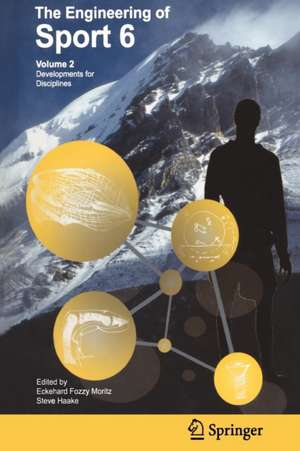Engineering of Sport 6: Volume 2: Developments for Disciplines
Editat de Eckehard Moritz, Steve Haakeen Limba Engleză Hardback – 20 aug 2006
| Toate formatele și edițiile | Preț | Express |
|---|---|---|
| Paperback (3) | 942.77 lei 6-8 săpt. | |
| Springer – 17 oct 2010 | 942.77 lei 6-8 săpt. | |
| Springer – 17 oct 2010 | 947.95 lei 6-8 săpt. | |
| Springer – 17 oct 2010 | 1220.54 lei 6-8 săpt. | |
| Hardback (3) | 952.26 lei 6-8 săpt. | |
| Springer – 20 aug 2006 | 952.26 lei 6-8 săpt. | |
| Springer – 20 aug 2006 | 956.99 lei 6-8 săpt. | |
| Springer – 22 aug 2006 | 1229.73 lei 6-8 săpt. |
Preț: 952.26 lei
Preț vechi: 1161.29 lei
-18% Nou
Puncte Express: 1428
Preț estimativ în valută:
182.27€ • 198.06$ • 153.21£
182.27€ • 198.06$ • 153.21£
Carte tipărită la comandă
Livrare economică 21 aprilie-05 mai
Preluare comenzi: 021 569.72.76
Specificații
ISBN-13: 9780387346786
ISBN-10: 0387346783
Pagini: 329
Ilustrații: XL, 330 p.
Dimensiuni: 155 x 235 x 22 mm
Greutate: 0.64 kg
Ediția:2006
Editura: Springer
Colecția Springer
Locul publicării:New York, NY, United States
ISBN-10: 0387346783
Pagini: 329
Ilustrații: XL, 330 p.
Dimensiuni: 155 x 235 x 22 mm
Greutate: 0.64 kg
Ediția:2006
Editura: Springer
Colecția Springer
Locul publicării:New York, NY, United States
Public țintă
ResearchDescriere
What you are holding in your hands is probably the best overview of activities in sports engineering available at the time of printing; i. e. the state of the art in summer 2006. It is the result of so many people's work to whom we are indebted that it is difficult to name them: there are the authors, the scientific advisory board, the scientific committee, the theme patrons, the publisher and printer, the advisors of whatever kind - and, here we have to make an exception, there is Ingo and Amanda. Nobody who has been part of the production of this book could have done without them, at the very least us: they handled issues you wouldn't even believe could tum up with efficiency and charm. Thanks, IngoValtingoier; thanks, Amanda Staley. In the accumulation of the contributions and the preparation of the proceedings we encountered one development that we were very happy about: the sports engineering community keeps growing - in the number or researchers and experts involved. but also in the breadth of disciplines and institutions contributing. This should definitely be interpreted as a positive development - even though in the evaluation of contributions this lead to a number of intricate discussions.
Cuprins
Biomechanics.- Synopsis of Current Developments: Biomechanics.- Influence of Footwear on In-Shoe Loading for Different Soil Densities.- Validation of a Full-Body Computer Simulation of the Golf Drive for Clubs of Differing Length.- Measurement of Hand Palm Pressures in “La Pelota Vasca” Game.- Analysis of the Relationship Between Mechanical Properties and Players’ Perception of the Balls in a Spanish Traditional Sport: “La Pilota Valenciana”.- Biomechanical Analysis of Running on Third Generation Artificial Soccer Turf.- Evaluation of Energy Expenditure Rate During Continuous Upper Body Cyclic Exercise.- Measurement Techniques.- Synopsis of Current Developments: Measurement Techniques.- Use of the Infrared Based Motion Capture System AS 200 in Sport Science.- Employing Modern Elements of Vehicle Navigation for Integrated Motion Measurement in Sport.- Time-Resolved Measurements of Grip Force During a Golf Shot.- Pacing Lights — a New Approach to Controlling Speed in the Gait Laboratory.- Measuring Equine Ground Reaction Forces.- Examination of a Swimming Dummy’s Flow Field Using Laser Doppler Velocimetry.- Head Accelerations During Soccer Heading.- A New Six Component Dynamometer for Measuring Ground Reaction Forces in Alpine Skiing.- Measurement of Draw-Length Alterations in the Final Pull in Archery.- Power Measurement During Rowing.- Modelling Equipment.- Synopsis of Current Developments: Modelling Equipment.- Large Deflections during Bounce of Inflated Balls.- Finite Element Simulation of Ice Axe Pick Impact on a Semi-Rigid Surface.- Optimization of the Handbike’s Drive Concept — Mathematical Approach.- Using CFD to Understand the Effects of Seam Geometry on Soccer Ball Aerodynamics.- Optimization of a Recurve Bow Riser Using Evolutionary Computing.- A Preliminary Investigation into Racing Motorcycle Aerodynamics.- A Comparison of Aerodynamic Drag of a Rugby Ball Using EFD and CFD.- Modelling Systems.- Synopsis of Current Developments: Modelling Systems.- Relating Grip Characteristics to the Dynamic Response of Tennis Racquets.- Modelling the ‘run-out’ Throw in Cricket.- Simulation Analysis of Maneuver in Skydiving.- The Measurement of Applied Pressure at Depth with Two Natural Soil Surfaces at Different Densities.- Methods of Simulation and Manipulation for the Evaluation of Figure Skating Jumps.- Computer-Aided Football Training: Exploiting Advances in Distributed Tactical Operations Research.- Modelling and Measurement Equipment in Skiing.- Synopsis of Current Developments: Modelling and Measurement Equipment in Skiing.- Modeling of the Ski-Snow Contact for a Carved Turn.- Improvements of Simulating Approach for Ski Turn.- Influence of Ski Bending Stiffness on the Turning Radius of Alpine Skis at Different Edging Angles and Velocities.- Study on Modification of Ski Referring Characteristic of Ski-Turn (Change of Width and Shoe Center).- A Unified, Custom-built Measuring System for a Ski Athlete.- Analysis of Binding Loads in Snowboarding from Field Data Acquisition.- Climbing — Pulley Mechanics and Taping.- Synopsis of Climbing — Pulley Mechanics and Taping.- Biomechanical Properties of the A2 Pulley in Rock Climbers.- Biomechanics of Finger Pulleys during Climbing.- Biomechanical Model for the Determination of the Forces acting on the Pulley System.- Impact of “Taping” after Finger Flexor Tendon Pulley Ruptures in Rock Climbers.- Mechanical Influence of Finger Taping in Sport Climbing.- Climbing — Technical Aspects of Training and Performance.- Synopsis of Climbing — Technical Aspects of Training and Performance.- Chronic Exertional Compartment Syndrome of Forearm Flexor Muscles in Rock Climbers — Evaluation of Physiological Standard Pressures.- Relation Between Specific Force Tests and Chained Degree in High Level Sport Climbers.- Dynamic Eccentric-Concentric Strength Training of the Finger Flexors to Improve Rock Climbing Performance.- Strength Measurement and Clinical Outcome after Conservatively Treated Pulley Ruptures in Climbers.- Evolvement and Experimentation of a New Interval Method For Strength Endurance Development.- Testing, Prototyping, Benchmarking.- Synopsis of Current Developments: Testing, Prototyping and Benchmarking.- Test Methods in the Development of Sports Equipment.- The Design and Implementation of a Crash Pad Evaluation System for Speed Skating.- Optimization of the Handbike’s Drive Concept — Experimental Approach.- Sports Surfaces — Impact Assessment Tools.
Textul de pe ultima copertă
The Engineering of Sport 6
The International Sports Engineering Association (ISEA) was launched in 1998 as a response to the enthusiasm created by the 1st and 2nd International Conferences on the Engineering of Sport. The primary aim of the ISEA is to act as a forum to discuss technical and scientific issues relating to sport and sport technology for those carrying out research and development in this field. The members of the ISEA come from a wide range of disciplines from engineering to sports science, from research organisations, universities and relevant industries world wide. Since the launch of ISEA in 1998 in Sheffield (UK), biannual conferences have took place in Sydney (Australia), Kyoto (Japan), and two years ago in Davis (USA). In 2006 the biannual conference is being held in Munich following the FIFA World Cup 2006 Germany. ISEA publishes the International Sports Engineering Journal, which represents one of the leading scholarly journals in the field of Sports Engineering, now in its 9th successful year.
The editors
"It is fitting that the biggest International Sports Engineering conference so far has been organised by Eckehard Fozzy Moritz. Fozzy is big both in stature and in ideas, willing to do as all good designers do in thinking outside the box. The conference, to which this proceedings refers, will have been an enjoyable affair since Fozzy rarely does anything without fun (or at least with an element of the unexpected)! Fozzy was instrumental in setting up DIVERS, the German society for sports engineering, and now has a dynamic group of people around him in his unique centre for innovation in sports, the SportKreativWerkstatt. The design of this proceedings is testament to the hard work of Fozzy and his team in the creation of something dynamic and yet different for the world of sports engineering." Stephen J. Haake
"Steve Haake IS sports engineering. With the organization of the first conference on sports engineering in 1996, and the editing of the very first set of proceedings on this topic, he was the one who made this field popular in the world and acceptable in academic circles. Further milestones followed that are all still successful today: The foundation of the International Sports Engineering Association that he has chaired for almost a decade, the establishment of a scientific journal on sports engineering, the origination of novel institutions like the Sports Engineering Network and SportsPulse in England; and since March 2006 Professor Haake is head of the Centre for Sports and Exercise Science at Sheffield Hallam University.
The secret to Steve's success is openness and hospitality. When I approached him in 1998, to learn more about sports engineering and how to relate this to my own field of innovation, Steve was simply inviting me over to his place and shared ideas, competence and knowledge with me. Similar encounters followed that greatly helped my work: I have to say I am very proud to have Steve as a co-editor of these proceedings." Eckehard Fozzy Moritz
The International Sports Engineering Association (ISEA) was launched in 1998 as a response to the enthusiasm created by the 1st and 2nd International Conferences on the Engineering of Sport. The primary aim of the ISEA is to act as a forum to discuss technical and scientific issues relating to sport and sport technology for those carrying out research and development in this field. The members of the ISEA come from a wide range of disciplines from engineering to sports science, from research organisations, universities and relevant industries world wide. Since the launch of ISEA in 1998 in Sheffield (UK), biannual conferences have took place in Sydney (Australia), Kyoto (Japan), and two years ago in Davis (USA). In 2006 the biannual conference is being held in Munich following the FIFA World Cup 2006 Germany. ISEA publishes the International Sports Engineering Journal, which represents one of the leading scholarly journals in the field of Sports Engineering, now in its 9th successful year.
The editors
"It is fitting that the biggest International Sports Engineering conference so far has been organised by Eckehard Fozzy Moritz. Fozzy is big both in stature and in ideas, willing to do as all good designers do in thinking outside the box. The conference, to which this proceedings refers, will have been an enjoyable affair since Fozzy rarely does anything without fun (or at least with an element of the unexpected)! Fozzy was instrumental in setting up DIVERS, the German society for sports engineering, and now has a dynamic group of people around him in his unique centre for innovation in sports, the SportKreativWerkstatt. The design of this proceedings is testament to the hard work of Fozzy and his team in the creation of something dynamic and yet different for the world of sports engineering." Stephen J. Haake
"Steve Haake IS sports engineering. With the organization of the first conference on sports engineering in 1996, and the editing of the very first set of proceedings on this topic, he was the one who made this field popular in the world and acceptable in academic circles. Further milestones followed that are all still successful today: The foundation of the International Sports Engineering Association that he has chaired for almost a decade, the establishment of a scientific journal on sports engineering, the origination of novel institutions like the Sports Engineering Network and SportsPulse in England; and since March 2006 Professor Haake is head of the Centre for Sports and Exercise Science at Sheffield Hallam University.
The secret to Steve's success is openness and hospitality. When I approached him in 1998, to learn more about sports engineering and how to relate this to my own field of innovation, Steve was simply inviting me over to his place and shared ideas, competence and knowledge with me. Similar encounters followed that greatly helped my work: I have to say I am very proud to have Steve as a co-editor of these proceedings." Eckehard Fozzy Moritz
Caracteristici
First title of its kind in the emerging field of sports technology

















